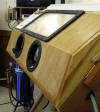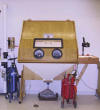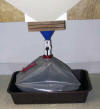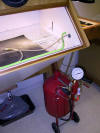Studio Resources
The following information describes my previous studio in Richland, Washington. The new place in Sequim is nearly complete, and these pages will be updated soon.
Blasting Cabinet (version 2.0)
Until May 2003, we used a second generation blast cabinet that I designed in 1998 to accommodate my aching back. The front of the cabinet articulated, and the glove ports are gel filled (mouse pads) to spare the forearms. Two pressure pots with 220 mesh Silicon Carbide, and 3/32, 1/16 and 1/32 inch nozzles provide the abrasive at about 25 psi, less for shading and contouring. I've attached a vibrating screen and funnel to the bottom of the booth, so that the screened abrasive falls fully contained into a 5 gallon REI collapsible water jug. Recharging the pressure pots is a simple matter of inverting the jug over the pot, and letting the abrasive flow into the pots through a piece of 3/4 inch PVC. Fully contained, no dust.
 Glass cabinet, front slightly open to allow glass insertion. Glass cabinet, front slightly open to allow glass insertion.
 Cabinet shown with front open for maintenance. Cabinet shown with front open for maintenance.
 Front of cabinet; this view shows mouse pads and 4 1/2 inch 60 pound gage that permits monitoring of lower pressures used for shading and contouring. Front of cabinet; this view shows mouse pads and 4 1/2 inch 60 pound gage that permits monitoring of lower pressures used for shading and contouring.
Blasting Cabinet (version 2.5)
In May 2003, I stopped carving glass for a few weeks, and remodeled the cabinet, building in some features that could make the multistage carving process a little easier. I guess it was angel feathers - doing 78 individual feathers one at a time (and raising a 26 pound door each time) that convinced me there had to be a better way.
 The front of the cabinet now slides up, and is counterweighted. The front of the cabinet now slides up, and is counterweighted.
 The abrasive falls through a filter, and into a five gallon water container. The container has a long 3/4 inch PVC tube that can be attached, and inserted into the pressure pot during recharge. No dust! The abrasive falls through a filter, and into a five gallon water container. The container has a long 3/4 inch PVC tube that can be attached, and inserted into the pressure pot during recharge. No dust!
 Big 3 1/2 inch gages sit on top of the cabinet, with handles that extend into the blast cabinet; I can finally tweak the pressure with one hand, while exercising the guns with the other. Big 3 1/2 inch gages sit on top of the cabinet, with handles that extend into the blast cabinet; I can finally tweak the pressure with one hand, while exercising the guns with the other.
 Another big gage - this one a 4 1/2 incher - sits on top of the right hand pressure pot, giving an accurate reading for those critical shading operations. Note two Bob Pickard-style guns. The pencil gun is controlled by a footswitch. Currently, we have two pressure pots for a single blast cabinet. We use 1/16 cone and straight nozzles in either system. Another big gage - this one a 4 1/2 incher - sits on top of the right hand pressure pot, giving an accurate reading for those critical shading operations. Note two Bob Pickard-style guns. The pencil gun is controlled by a footswitch. Currently, we have two pressure pots for a single blast cabinet. We use 1/16 cone and straight nozzles in either system.
 And now, the whole reason why I did this - a drawer sits on the right hand side, shuttling artwork from inside the closed cabinet to the peeling workstation outside. (I've left the front open in this picture so you can see the operation better.) And now, the whole reason why I did this - a drawer sits on the right hand side, shuttling artwork from inside the closed cabinet to the peeling workstation outside. (I've left the front open in this picture so you can see the operation better.)
 Another view of the drawer, halfway in between. Another view of the drawer, halfway in between.
Edge light tool
 Most of the work we do is multistage carved. Often, a piece that looks great under the lights in the cabinet, displays subtle flaws when edge lit. The solution was to edge light the glass during blasting. Most of the work we do is multistage carved. Often, a piece that looks great under the lights in the cabinet, displays subtle flaws when edge lit. The solution was to edge light the glass during blasting.
Support Equipment
 Dust collection and compressor each have their own utility buildings, attached to the house. This cuts down noise, and reduces chances for dust problems. Dust collection and compressor each have their own utility buildings, attached to the house. This cuts down noise, and reduces chances for dust problems.
The one micron filter shown at the left was fabricated by American Fabric Filter to fit over a standard five gallon bucket, and mates to a Grizzly one-horse dust collector.
|